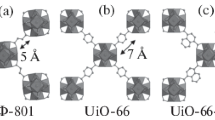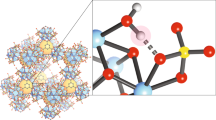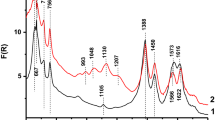Abstract
Brønsted-acid sites are introduced via –OSO3H groups on the coordinatively unsaturated ZrO2 nodes of UiO-66 metal organic frameworks (MOFs). Such groups create strong Brønsted acidic sites that are active for cyclohexanol and ethanol dehydration (in liquid organic phase and gas phase, respectively). The intrinsic activity of Brønsted acid sites at nodes increased by increasing the concentration of sulfur, which is attributed to a shift from isolated µ3 − OSO3H to two groups [(µ3 − OSO3H)2] interacting via hydrogen bonding. For cyclohexanol dehydration, the relatively low activation enthalpies and negative transition entropies point to an E2 elimination mechanism, similar to dehydration with MFI zeolites in organic solvents. Our results, show that the catalytic activity can be manipulated via the functionalization of zirconia nodes of the MOF framework.



Similar content being viewed by others
References
Baertsch CD, Komala KT, Chua YH, Iglesia E Genesis of Bronsted acid sites during dehydration of 2-butanol on tungsten oxide catalysts. (2002) 205 (1), 44–57. Pfriem, N.; Liu, Y.; Zahn, F.; Shi, H.; Haller, G. L.; Lercher, J. A. Impact of the Local Concentration of Hydronium Ions at Tungstate Surfaces for Acid-Catalyzed Alcohol Dehydration. Journal of the American Chemical Society 2021, 143 (48), 20133–20143
Eckstein S, Hintermeier PH, Zhao R, Baráth E, Shi H, Liu Y, Lercher JA (2019) Influence of Hydronium Ions in Zeolites on Sorption. Angew Chem Int Ed 58(11):3450–3455. https://doi.org/10.1002/anie.201812184(acccessed 2021/01/23)
Liu Y, Baráth E, Shi H, Hu J, Camaioni DM, Lercher JA (2018) Solvent-determined mechanistic pathways in zeolite-H-BEA-catalysed phenol alkylation. Nat Catal 1(2):141–147. https://doi.org/10.1038/s41929-017-0015-z
Li H, Wang K, Sun Y, Lollar CT, Li J, Zhou H-C Recent advances in gas storage and separation using metal–organic frameworks., Zheng J, Vemuri RS, Estevez L, Koech PK, Vargas T, Camaioni DM, Blake TA, McGrail BP, Motkuri RK, Motkuri RK, Annapureddy HVR, Vijaykumar M, Schaef HT, Martin PF, McGrail BP, Dang LX, Krishna R, Thallapally PK, Chen ZJ, Kirlikovali KO, Idrees KB, Wasson MC, Farha OK (2018) 21 (2), 108–121. DOI: https://doi.org/10.1016/j.mattod.2017.07.006. Zheng, J.; Barpaga, D.; Trump, B. A.; Shetty, M.; Fan, Y. Z.; Bhattacharya, P.; Jenks, J. J.; Su, C. Y.; Brown, C. M.; Maurin, G.;. Molecular Insight into Fluorocarbon Adsorption in Pore Expanded Metal-Organic Framework Analogs. Journal of the American Chemical Society 2020, 142 (6), 3002–3012. Zheng J, Vemuri RS, Estevez L, Koech PK, Vargas T, Camaioni DM, Blake TA, McGrail BP, Motkuri RK Pore-Engineered Metal-Organic Frameworks with Excellent Adsorption of Water and Fluorocarbon Refrigerant for Cooling Applications. Journal of the American Chemical Society 2017, 139 (31), 10601–10604. Ozkan, M.; Akhavi, A. A.; Coley, W. C.; Shang, R. X.; Ma, Y. Progress in carbon dioxide capture materials for deep decarbonization. Chem-Us 2022, 8 (1), 141–173. Motkuri RK, Annapureddy HVR, Vijaykumar M, Schaef HT, Martin PF, McGrail BP, Dang LX, Krishna R, Thallapally PK. Fluorocarbon adsorption in hierarchical porous frameworks. Nature Communications 2014, 5. Barpaga, D.; Zheng, J.; McGrail, B. P.; Motkuri, R. K. Manipulating Pore Topology and Functionality to Promote Fluorocarbon-Based Adsorption Cooling. Accounts Chem Res 2021. Chen ZJ, Kirlikovali KO, Idrees KB, Wasson MC, Farha OK Porous materials for hydrogen storage. Chem-Us 2022, 8 (3), 693–716. Zheng, J.; Wahiduzzaman, M.; Barpaga, D.; Trump, B. A.; Gutierrez, O. Y.; Thallapally, P.; Ma, S. Q.; McGrail, B. P.; Maurin, G.; Motkuri, R. K. Porous Covalent Organic Polymers for Efficient Fluorocarbon-Based Adsorption Cooling. Angew Chem Int Edit 2021, 60 (33), 18037–18043
Li J-R, Sculley J, Zhou H-C Metal–Organic Frameworks for Separations., Xiang R-B, Xing S, Zhou H, Chen W (2012) 112 (2), 869–932. DOI: 10.1021/cr200190s. Yuan, S.; Feng, L.; Wang, K.; Pang, J.; Bosch, M.; Lollar, C.; Sun, Y.; Qin, J.; Yang, X.; Zhang, P.;. Stable Metal–Organic Frameworks: Design, Synthesis, and Applications. Advanced Materials 2018, 30 (37), 1704303. DOI: 10.1002/adma.201704303. Lin, Xiang R-B, Xing S, Zhou H, Chen W, B. Exploration of porous metal–organic frameworks for gas separation and purification. Coordination Chemistry Reviews 2019, 378, 87–103. DOI: https://doi.org/10.1016/j.ccr.2017.09.027. Motkuri, R. K.; Thallapally, P. K.; Annapureddy, H. V. R.; Dang, L. X.; Krishna, R.; Nune, S. K.; Fernandez, C. A.; Liu, J.; McGrail, B. P. Separation of polar compounds using a flexible metal-organic framework. Chem Commun 2015, 51 (40), 8421–8424
Rimoldi M, Howarth AJ, DeStefano MR, Lin L, Goswami S, Li P, Hupp JT, Farha OK Catalytic Zirconium/Hafnium-Based Metal–Organic Frameworks., Frameworks for Heterogeneous Basic Catalysis, Corma A, García H, Llabrés i Xamena FX, Wang C, An B, Lin W, Aijaz A, Xu Q, Rogge SMJ, Bavykina A, Hajek J, Garcia H, Olivos-Suarez AI, Sepúlveda-Escribano A, Vimont A, Clet G, Bazin P, Kapteijn F, Sudarsanam P, Zhong R, Van den Bosch S, Coman SM, Parvulescu VI, Sels BF, Dhakshinamoorthy F, Li A, Garcia Z (2017) 7 (2), 997–1014. DOI: https://doi.org/10.1021/acscatal.6b02923. Zhu, L.; Liu, X.-Q.; Jiang, H.-L.; Sun, L.-B. Metal–Organic. Chemical Reviews 2017, 117 (12), 8129–8176. DOI: 10.1021/acs.chemrev.7b00091. Corma A, García H, Llabrés i Xamena FX Engineering Metal Organic Frameworks for Heterogeneous Catalysis. Chemical Reviews 2010, 110 (8), 4606–4655. DOI: 10.1021/cr9003924. Zeng, L.; Guo, X.; He, C.; Duan, C. Metal–Organic Frameworks: Versatile Materials for Heterogeneous Photocatalysis. ACS Catalysis 2016, 6 (11), 7935–7947. DOI: 10.1021/acscatal.6b02228. Wang C, An B, Lin W Metal–Organic Frameworks in Solid–Gas Phase Catalysis. ACS Catalysis 2019, 9 (1), 130–146. DOI: 10.1021/acscatal.8b04055. Yoon, M.; Srirambalaji, R.; Kim, K. Homochiral Metal–Organic Frameworks for Asymmetric Heterogeneous Catalysis. Chemical Reviews 2012, 112 (2), 1196–1231. DOI: 10.1021/cr2003147. Aijaz A, Xu Q Catalysis with Metal Nanoparticles Immobilized within the Pores of Metal–Organic Frameworks. The Journal of Physical Chemistry Letters 2014, 5 (8), 1400–1411. DOI: 10.1021/jz5004044. Chughtai, A. H.; Ahmad, N.; Younus, H. A.; Laypkov, A.; Verpoort, F. Metal–organic frameworks: versatile heterogeneous catalysts for efficient catalytic organic transformations. Chemical Society Reviews 2015, 44 (19), 6804–6849, 10.1039/C4CS00395K. DOI: 10.1039/C4CS00395K. Rogge SMJ, Bavykina A, Hajek J, Garcia H, Olivos-Suarez AI, Sepúlveda-Escribano A, Vimont A, Clet G, Bazin P, Kapteijn F. Metal–organic and covalent organic frameworks as single-site catalysts. Chemical Society Reviews 2017, 46 (11), 3134–3184, 10.1039/C7CS00033B. DOI: 10.1039/C7CS00033B. Huang, Y.-B.; Liang, J.; Wang, X.-S.; Cao, R. Multifunctional metal–organic framework catalysts: synergistic catalysis and tandem reactions. Chemical Society Reviews 2017, 46 (1), 126–157, 10.1039/C6CS00250A. DOI: 10.1039/C6CS00250A. Sudarsanam P, Zhong R, Van den Bosch S, Coman SM, Parvulescu VI, Sels BF Functionalised heterogeneous catalysts for sustainable biomass valorisation. Chemical Society Reviews 2018, 47 (22), 8349–8402, 10.1039/C8CS00410B. DOI: 10.1039/C8CS00410B. Lee, J.; Farha, O. K.; Roberts, J.; Scheidt, K. A.; Nguyen, S. T.; Hupp, J. T. Metal–organic framework materials as catalysts. Chemical Society Reviews 2009, 38 (5), 1450–1459, 10.1039/B807080F. DOI: 10.1039/B807080Dhakshinamoorthy F, Li A, Garcia Z, H. Catalysis and photocatalysis by metal organic frameworks. Chemical Society Reviews 2018, 47 (22), 8134–8172, 10.1039/C8CS00256H. DOI: 10.1039/C8CS00256H. Zheng, J.; Ye, J. Y.; Ortuno, M. A.; Fulton, J. L.; Gutierrez, O. Y.; Camaioni, D. M.; Motkuri, R. K.; Li, Z. Y.; Webber, T. E.; Mehdi, B. L.; Selective Methane Oxidation to Methanol on Cu-Oxo Dimers Stabilized by Zirconia Nodes of an NU-1000 Metal-Organic Framework. Journal of the American Chemical Society 2019, 141 (23), 9292–9304
Jiang J, Yaghi OM (2015) Brønsted Acidity in Metal–Organic Frameworks. Chem Rev 115(14):6966–6997. https://doi.org/10.1021/acs.chemrev.5b00221
Devarajan N, Suresh P MIL-101-SO3H metal–organic framework as a Brønsted acid catalyst in Hantzsch reaction: an efficient and sustainable methodology for one-pot synthesis of 1,4-dihydropyridine., Juan-Alcañiz J, Gielisse R, Lago AB, Ramos-Fernandez EV, Serra-Crespo P, Devic T, Guillou N, Serre C, Kapteijn F, Gascon J (2019) 43 (17), 6806–6814, 10.1039/C9NJ00990F. DOI: 10.1039/C9NJ00990F. Goesten, M. G.; Juan-Alcañiz, J.; Ramos-Fernandez, E. V.; Sai Sankar Gupta, K. B.; Stavitski, E.; van Bekkum, H.; Gascon, J.; Kapteijn, F. Sulfation of metal–organic frameworks: Opportunities for acid catalysis and proton conductivity. Journal of Catalysis 2011, 281 (1), 177–187. DOI: https://doi.org/10.1016/j.jcat.2011.04.015. Juan-Alcañiz J, Gielisse R, Lago AB, Ramos-Fernandez EV, Serra-Crespo P, Devic T, Guillou N, Serre C, Kapteijn F, Gascon J Towards acid MOFs – catalytic performance of sulfonic acid functionalized architectures. Catalysis Science & Technology 2013, 3 (9), 2311–2318, 10.1039/C3CY00272A. DOI: 10.1039/C3CY00272A
Trickett CA, Popp TMO, Su J, Yan C, Weisberg J, Huq A, Urban P, Jiang JC, Kalmutzki MJ, Liu QN et al (2019) Identification of the strong bronsted acid site in a metal-organic framework solid acid catalyst. Nat Chem 11(2):170–176
Akiyama G, Matsuda R, Sato H, Takata M, Kitagawa S (2011) Cellulose hydrolysis by a New Porous Coordination Polymer decorated with Sulfonic Acid Functional Groups. Adv Mater 23(29):3294–3297. https://doi.org/10.1002/adma.201101356
Jiang J, Gándara F, Zhang Y-B, Na K, Yaghi OM, Klemperer WG (2014) Superacidity in Sulfated Metal–Organic Framework-808. J Am Chem Soc 136(37):12844–12847. https://doi.org/10.1021/ja507119n
Valenzano L, Civalleri B, Chavan S, Bordiga S, Nilsen MH, Jakobsen S, Lillerud KP, Lamberti C (2011) Disclosing the Complex structure of UiO-66 metal Organic Framework: a synergic combination of experiment and theory. Chem Mater 23(7):1700–1718. https://doi.org/10.1021/cm1022882
Bensitel M, Saur O, Lavalley JC, Morrow BA An Infrared Study of Sulfated Zirconia. (1988) 19 (1–2), 147–156. DOI: Doi 10.1016/0254–0584(88)90007-7. Fottinger, K.; Vinek, H. Activation and deactivation of Pt containing sulfated zirconia and sulfated zirconia studied by in situ IR spectroscopy. Catal Lett 2004, 97 (3–4), 131–138. DOI: DOI https://doi.org/10.1023/B:CATL.0000038574.41106.a1
Li XB, Nagaoka K, Olindo R, Lercher JA (2006) Synthesis of highly active sulfated zirconia by sulfation with SO3. J Catal 238(1):39–45. https://doi.org/10.1016/j.jcat.2005.11.039
Benesi HA Determination of proton acidity of solid catalysts by chromatographic adsorption of sterically hindered amines. (1973) 28 (1), 176–178. DOI: https://doi.org/10.1016/0021-9517(73)90192-9. Jacobs, P. A.; Heylen, C. F. Active sites in zeolites: III. Selective poisoning of Bronsted sites on synthetic Y zeolites. Journal of Catalysis 1974, 34 (2), 267–274. DOI: https://doi.org/10.1016/0021-9517(74)90036-0
Chen F, Shetty M, Wang M, Shi H, Liu Y, Camaioni DM, Gutiérrez OY, Lercher JA (2021) Differences in mechanism and rate of Zeolite-Catalyzed Cyclohexanol Dehydration in Apolar and Aqueous Phase. ACS Catal 11(5):2879–2888. https://doi.org/10.1021/acscatal.0c05674
Zhi Y, Shi H, Mu L, Liu Y, Mei D, Camaioni DM, Lercher JA (2015) Dehydration pathways of 1-Propanol on HZSM-5 in the Presence and absence of Water. J Am Chem Soc 137(50):15781–15794. https://doi.org/10.1021/jacs.5b09107
Acknowledgements
This work was supported by the Inorganometallic Catalyst Design Center and the Catalyst Design for Decarbonization Center, Energy Frontier Research Centers funded by the U.S. Department of Energy (DOE), Office of Science, Basic Energy Sciences (BES), under Awards DE-SC0012702 and DE-SC0023383. F.C., S.K., J.L.F., and D.M.C. were supported by the U.S. Department of Energy, Office of Science, Office of Basic Energy Sciences, Division of Chemical Sciences, Geosciences and Biosciences (FWP 47319). We acknowledge Jian Zheng for assistance with characterization and the Paul Scherrer Institut, Villigen, Switzerland for the provision of synchrotron radiation beamtime at the PHOENIX beamline and would like to thank Dr. Thomas Huthwelker and Dr. Camelia Nicoleta Borca for the XAS measurement.
Author information
Authors and Affiliations
Corresponding authors
Ethics declarations
Competing interests
The authors declare no competing financial interest.
Additional information
Publisher’s Note
Springer Nature remains neutral with regard to jurisdictional claims in published maps and institutional affiliations.
Electronic Supplementary Material
Below is the link to the electronic supplementary material.
Rights and permissions
Springer Nature or its licensor (e.g. a society or other partner) holds exclusive rights to this article under a publishing agreement with the author(s) or other rightsholder(s); author self-archiving of the accepted manuscript version of this article is solely governed by the terms of such publishing agreement and applicable law.
About this article
Cite this article
Chen, F., Kim, S., Barpaga, D. et al. Activity of Brønsted Acid Sites in UiO-66 for Cyclohexanol Dehydration. Top Catal 66, 1196–1201 (2023). https://doi.org/10.1007/s11244-023-01830-7
Accepted:
Published:
Issue Date:
DOI: https://doi.org/10.1007/s11244-023-01830-7




